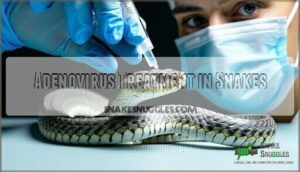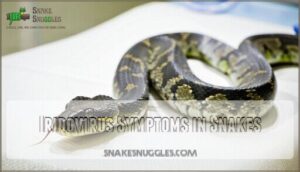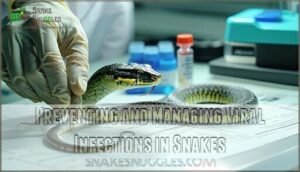This site is supported by our readers. We may earn a commission, at no cost to you, if you purchase through links.
 You’re wondering if snakes can get viruses – the answer is yes, they can.
You’re wondering if snakes can get viruses – the answer is yes, they can.
Viral infections like inclusion body disease and adenovirus can affect snakes, causing symptoms from mild to severe.
As a snake owner, this is vital to know and take preventive measures. You’ll want to learn more about the types of viruses that can harm your pet and how to keep them safe.
Let’s explore snake viruses and discover what you can do to protect your slithery friend.
Table Of Contents
- Key Takeaways
- Can Snakes Get Viruses?
- Do Dead Snakes Carry Diseases?
- Adenovirus in Snakes
- Herpesviridae in Reptiles
- Iridoviridae and Its Impact on Snakes
- Poxviridae in Reptiles
- Nidovirus in Snakes
- Papillomaviridae and Its Effects on Snakes
- Parvoviridae and Circoviridae in Snakes
- Preventing and Managing Viral Infections in Snakes
- Frequently Asked Questions (FAQs)
- Can snakes carry viruses?
- Can snakes get ill?
- Can snakes get STDs?
- How to tell if a snake has an infection?
- Do dead snakes carry diseases?
- Can snakes get adenovirus?
- Do snakes get fevers?
- What are the common symptoms of viral infections in snakes?
- How do viral infections affect a snakes respiratory system?
- Can snakes transmit viral infections to other animals?
- Conclusion
Key Takeaways
- You can protect your pet snake from viral infections by practicing good hygiene, regularly sanitizing its enclosure, and scheduling veterinary checkups.
- Snakes can carry and transmit viruses like nidovirus, paramyxovirus, and adenovirus, which can cause respiratory problems, neurological issues, and even death if left untreated.
- If you suspect your snake has a viral infection, look out for signs like respiratory distress, nasal discharge, or abnormal behavior, and consult a vet for proper diagnosis and treatment.
- Quarantining new snakes, maintaining a clean environment, and providing supportive care can help manage and prevent the spread of viral infections in your pet snake.
Can Snakes Get Viruses?
Yes, snakes can and do get viruses—in fact, they’re susceptible to several serious viral infections that can devastate both wild and captive populations.
Snakes can get serious viral infections that devastate populations
From inclusion body disease in pythons and boas to highly contagious paramyxoviruses in vipers, these microscopic threats pose real challenges for reptile owners and wildlife alike.
Types of Viruses Affecting Snakes
Your scaly friend can catch various snake viruses just like other pets.
Reptile viruses include Snake Retroviruses, Serpentoviruses Threat (nidoviruses), and Viper Paramyxoviruses.
IBD Causation involves arenaviruses, while Adeno/Reoviruses and herpesvirus also threaten snakes.
These snake virus types range from respiratory infections to fatal diseases, making prevention essential for your pet’s health.
Snakes are also vulnerable to paramyxoviruses, but chelonians face herpesviruses more often.
Common Viral Infections in Snakes
In regards to snake viruses, the most common include Inclusion Body Disease (IBD), Adenovirus, Herpesvirus, Iridovirus, Poxvirus, Nidovirus, and Papillomavirus.
These viral infections in snakes show up as anything from sluggish moves to severe systemic disease.
Some snakes become asymptomatic carriers, making Viral Diagnostics essential for catching problems early and reducing hidden morbidity factors in your collection.
Iridoviruses, for example, are icosahedral DNA viruses that infect both vertebrates and invertebrates, and are a type of snake viruses that can cause significant harm, highlighting the importance of understanding viral infections.
Risk Factors for Viral Infections in Snakes
Here’s the short list of snake virus risk factors that could put your slinky buddy in harm’s way:
- Stress and Immunity: Just like people, stress can crash your snake’s immune system, rolling out the welcome mat for infections.
- Poor Husbandry: Letting cages get dirty or stuffy? You’re basically inviting viruses to the party.
- Genetic Predisposition: Some snakes, thanks to their genes, naturally catch bugs more easily—no matter how clean their digs.
Do Dead Snakes Carry Diseases?
You might think a snake stops being a problem when it’s gone, but even a dead one can still carry diseases.
Give it space and stay safe—nobody wants to end up explaining a weird rash at school, right?
Viral Load in Dead Snakes
When a snake dies, consider the viral load it may carry.
Postmortem analysis and necropsy help assess disease levels, ensuring ethical handling and disposal safety to prevent outbreaks, especially for viral infections in snakes, through proper viral investigations of dead snakes.
A snake necropsy kit aids in this process, facilitating a safe and informed approach to handling deceased snakes and understanding the potential disease levels they may carry.
Disease Transmission From Dead Snakes
You’re at risk of contracting diseases like Inclusion Body Disease from dead snakes. Viral persistence is a concern.
To minimize disease transmission, take handling precautions:
- Wear protective gear
- Avoid bodily fluids
- Keep areas clean
- Prevent environmental contamination
Using specialized handling equipment can further reduce risk. Follow proper disposal methods to reduce necropsy risks and viral infections from dead snakes, and always consider viral persistence.
Safe Handling of Dead Snakes
When dealing with dead snakes, wear protective gear, like gloves, to prevent disease transmission.
For enhanced safety, consider using specialized handling equipment.
Double-bag the snake and seal it tightly.
Consider local disposal methods to minimize zoonotic risks and promote safe handling, reducing viral persistence and promoting biosecurity measures to guarantee safe handling, reducing viral persistence and promoting biosecurity measures.
Adenovirus in Snakes
If you’re worried about adenovirus affecting your snake, you’re right to be concerned since this virus can infect both snakes and lizards without always showing obvious symptoms.
While some infected reptiles mightn’t seem sick at first, adenovirus can still spread between animals and potentially cause serious health problems down the road, which is a serious concern.
Adenovirus Symptoms in Snakes
Your snake’s behavior might change dramatically when adenovirus strikes.
This viral infection can affect multiple body systems, creating a cascade of concerning symptoms.
Watch for these telltale signs:
- Respiratory Distress – Open-mouth breathing, wheezing, or unusual breathing patterns that seem labored
- Digestive Issues – Regurgitation, diarrhea, or complete loss of appetite lasting several days
- Neurological Signs – Tremors, disorientation, or abnormal posturing that affects normal movement
Adenovirus symptoms in snakes often include systemic effects like weight loss and lethargy.
Skin lesions may appear alongside these snake virus adenovirus manifestations.
These viral infections snakes experience can progress quickly, making early recognition vital for your pet’s wellbeing.
Adenovirus Transmission in Snakes
Several routes make adenovirus transmission a real concern for snake owners. The fecal-oral route remains the primary pathway, where healthy snakes ingest contaminated feces.
Environmental contamination spreads through shared water bowls, substrate, and equipment. Asymptomatic carriers silently shed virus without showing symptoms, making detection tricky. Co-infections often complicate diagnosis when multiple pathogens strike simultaneously.
| Transmission Method | Risk Level |
|---|---|
| Fecal-Oral Route | High |
| Environmental Contamination | Medium |
| Asymptomatic Carriers | High |
| Co-infections | Medium |
Vertical transmission from parent to offspring adds another layer of complexity to managing viral infections snakes face in captivity.
Adenovirus Treatment in Snakes
Unfortunately, there’s no magic pill for snake virus treatment in regards to adenovirus in snakes. Your best bet is rolling up your sleeves for supportive therapies while your scaly friend fights this battle.
Here’s your game plan:
- Maintain ideal temperature and humidity to reduce stress on your snake’s immune system
- Provide antibiotics to prevent secondary infections that often complicate recovery
- Monitor closely for weight loss and dehydration, adjusting care accordingly
- Isolate infected snakes for at least 90 days to prevent spread
- Consider prognosis factors like age and overall health when planning treatment
Antiviral research shows limited options, though experimental treatments continue developing. Remember, early intervention improves outcomes substantially.
Herpesviridae in Reptiles
You’ll encounter herpesviruses in various reptile species, making them one of the most widespread viral threats to your scaly pets.
These DNA viruses can cause anything from mild skin lesions to deadly systemic infections that’ll have you rushing to the vet.
Herpesvirus Types in Reptiles
Five major types of reptile herpesviruses threaten your scaly friends, with Herpesvirus Prevalence varying by species.
Chelonian alphaherpesviruses dominate turtle populations, while Species Susceptibility differs dramatically between snakes and lizards.
Reptile Immunity struggles against these persistent snake viruses, which exploit Latency Mechanisms to hide dormant in nerve cells.
Environmental Factors like stress trigger reactivation, making herpesvirus a sneaky opponent in reptile viruses management.
Herpesvirus Symptoms in Reptiles
Herpesvirus symptoms in reptiles range from mild to life-threatening conditions you’ll want to catch early.
Watch for skin lesions, oral ulcers, and conjunctivitis around your pet’s eyes.
Neurological signs like tremors or abnormal movement patterns signal serious infection.
Respiratory issues including mouth breathing and nasal discharge are common red flags.
Ocular abnormalities such as swollen eyelids or discharge require immediate attention.
Systemic effects can impact liver function and overall health, making early detection essential for your reptile’s survival.
Herpesvirus Treatment in Reptiles
Spotting those herpesvirus symptoms? Let’s tackle what to do next. There’s no magic bullet, but you’ve got options to help your reptile feel better and keep your whole collection safe.
Treating snake viruses means being smart about snake virus treatment in snakes. The approach involves a combination of treatments and preventive measures to ensure the best outcome for your pet.
- Antiviral medications like acyclovir may ease symptoms and cut down on secondary bugs.
- Supportive therapies, including fluids and high-quality food, help boost recovery.
- Isolating your pet and focusing on long-term management and prevention strategies keeps other reptiles in the clear.
Think of it as a toolbox for better reptile health!
Iridoviridae and Its Impact on Snakes
You know viruses don’t just pick on people—Iridoviridae can cause some real trouble for your pet snake, too.
If your reptile starts acting like it’s having a really bad day, there’s a chance this tough virus family is behind it, specifically the Iridoviridae.
Iridovirus Symptoms in Snakes
Ever notice your snake turning into a couch potato? Lethargy, anorexia, and trouble breathing are classic iridovirus symptoms you can’t ignore.
Watch for skin lesions, odd behavioral changes, and organ damage—these viral infections really mean business. Diagnostic challenges can make things tricky, and with high mortality rates in some cases, catching snake virus symptoms early can make all the difference.
Early diagnosis can be aided by respiratory pathogen testing.
| Symptom | Description |
|---|---|
| Lethargy | Lack of energy, movement |
| Anorexia | Loss of appetite |
| Dyspnea | Difficulty breathing |
Iridovirus Transmission in Snakes
Here’s how iridovirus spreads in snakes:
- Direct contact: Touching infected snakes or contaminated surfaces.
- Contaminated feces: Feces can carry the virus, so clean enclosures regularly.
- Environmental persistence: The virus can survive outside a host for a while.
- Vertical transmission: Infected mothers can pass it to their offspring.
Maintain good hygiene, wash your hands, and quarantine new snakes to minimize the risk.
Iridovirus Treatment in Snakes
Unfortunately, there’s no cure for iridovirus in snakes.
Your best option is supportive care – maintaining proper temperature, humidity, and nutrition while isolating infected animals.
Antiviral research shows promise, but experimental treatments remain limited.
Supportive therapies help manage symptoms like neurological disorders and pneumonia.
The long-term prognosis varies, though future directions in treatment development offer hope for better outcomes.
Poxviridae in Reptiles
Poxviruses aren’t just a problem for mammals – they can infect your reptiles too, especially crocodilians like caimans and crocodiles.
You’ll spot these infections as raised, wart-like skin lesions that can spread across your pet’s body if left untreated, which is a significant concern for reptiles.
Poxvirus Symptoms in Reptiles
You notice skin lesions, scale abnormalities, and systemic signs in infected reptiles.
- Wart-like growths
- Lesions on mucous membranes
- Skin thickening
- Difficulty shedding
- Lethargy, affecting mortality rates.
Diagnostic methods help identify poxviridae, a snake virus causing poxvirus symptoms in snakes, a type of viral infection and reptile disease.
Poxvirus Transmission in Reptiles
You’re concerned about poxvirus transmission in reptiles.
Poxvirus spreads through direct contact and contaminated environments, threatening your reptile’s health.
Poxviruses spread through direct contact with infected skin lesions or mucous membranes.
Methods include direct contact, indirect contact, and vector-borne transmission.
Understanding poxvirus vectors and environmental factors can help prevent the spread of viral infections in snakes and other reptiles, reducing species susceptibility.
Poxvirus Treatment in Reptiles
Treating your reptile’s run-in with poxvirus isn’t rocket science, but you do need a plan.
Here’s the scoop:
- Isolate and quarantine to limit the spread of viral infections.
- Offer supportive therapy, focusing on hydration and nutrition.
- Consult a vet for lesion management and antiviral medications.
- Watch for secondary infections—sometimes bacteria play sidekick in snake diseases, affecting prognosis factors in snake virus treatment.
Nidovirus in Snakes
Nidovirus is a sneaky virus that can hit your pet snake pretty hard, often showing up as nasty respiratory problems.
You mightn’t spot it at first, but this bug loves to hide and spread, kind of like the germs your little brother brings home from school, which can be a pretty nasty experience.
Nidovirus Symptoms in Snakes
Regarding snake virus symptoms in snakes, nidovirus is nothing to sneeze at. Watch for Respiratory Distress—like wheezing or open-mouth breathing—plus fatigue, appetite loss, and weight drop.
Neurological signs, while rare, can show up as odd wobbles. These viral infections can hit hard, raising Morbidity Rates with some cases leading to Systemic Disease.
- Feeling powerless watching your pet struggle?
- Worry about invisible Asymptomatic Carriers in your reptile room?
- Fearful of losing a cherished python to snake diseases?
Nidovirus Transmission in Snakes
Understanding nidovirus transmission helps you protect your snake collection from this devastating disease.
This snake virus spreads through multiple pathways that make containment challenging:
- Direct contact transmission – Physical contact with infected snakes, their bodily fluids, or contaminated surfaces spreads the virus rapidly between animals.
- Environmental factors – Contaminated enclosures, shared equipment, and poor ventilation create ideal conditions for viral infections to persist and spread.
- Asymptomatic carriers – Infected snakes may show no symptoms while shedding virus, making diagnostic challenges particularly difficult for snake owners.
- Inter-species spread – Nidovirus can jump between different snake species, with vertical transmission from parent to offspring also possible.
Diagnosis often requires PCR-based detection.
Nidovirus Treatment in Snakes
You’re dealing with a snake virus, specifically nidovirus.
Sadly, there’s no cure, but supportive care helps.
Isolation, stress-free environment, and plenty of food and water are key.
Antibiotics may be prescribed to prevent secondary infections, with prognosis often poor, but supportive therapies and antiviral research offer hope.
Papillomaviridae and Its Effects on Snakes
You’re probably wondering if snakes can get viruses, and the answer is yes, they can.
Papillomaviridae is one type of virus that affects snakes, and to maintain your pet snake’s health, you need to understand its symptoms, transmission, and treatment.
Papillomavirus Symptoms in Snakes
You’re checking your snake’s skin and notice some issues.
Look for these papillomavirus symptoms:
- Rough, scaly patches
- Abnormal growths or warts
- Discoloration or thickening of the skin, which can indicate Wart Morphology and Lesion Distribution, related to snake virus papillomavirus, a viral infection in snakes.
Papillomavirus Transmission in Snakes
You’ll want to watch out for snake-to-snake contact and environmental factors like contaminated food or water that can spread papillomavirus in snakes.
Making them asymptomatic carriers with viral shedding, and considering environmental persistence.
Papillomavirus Treatment in Snakes
Your snake’s papillomavirus won’t vanish overnight, but you’ve got options.
Surgical removal works best for single growths, though they’ll regrow 50% of the time.
Most papillomaviridae infections actually resolve naturally through your snake’s immune system within six months.
Supportive care with ideal temperatures and nutrition helps speed recovery.
Experimental treatments like cryotherapy show promise for stubborn cases.
Parvoviridae and Circoviridae in Snakes
You’ll find that parvoviruses and circoviruses represent emerging threats in reptile medicine, though research on these small DNA viruses in snakes remains limited.
These viruses can cause serious health issues in your pet snake, making early recognition essential for proper care.
Parvovirus Symptoms in Snakes
Parvoviruses can sneak up on your snake like uninvited guests.
Digestive Issues and Lethargy Signs often appear first, followed by Scale Abnormalities and potential Neurological Impact.
These lifethreatening viral infections weaken your snake’s immune system, opening doors to Secondary Infections.
Since research on snake virus parvovirus remains limited, recognizing these snake disease symptoms early becomes essential for your pet’s survival.
Parvovirus Transmission in Snakes
Parvovirus shedding spreads this deadly virus through contaminated feces, saliva, and bodily fluids.
The fecal-oral route remains the primary transmission method, while carrier snakes unknowingly spread infection.
Environmental stability means parvoviruses survive on surfaces for weeks.
Vertical transmission from mother to offspring also occurs.
Proper quarantine and disinfection prevent viral infections in your collection.
Parvovirus Treatment in Snakes
Since parvoviruses spread easily, immediate treatment focus becomes your snake’s lifeline. Unfortunately, no antiviral therapies exist for these viral infections, making supportive care your only weapon against this deadly threat. PCR testing can accurately identify the virus.
Your treatment approach should center on these key strategies:
- Fluid therapy – Combat dehydration with subcutaneous fluids (10-20 mL/kg every 24-48 hours) to replace losses from vomiting
- Antimicrobial support – Prevent secondary bacterial infections with broad-spectrum antibiotics like enrofloxacin
- Nutritional assistance – Maintain gut health through tube feeding with easily digestible diets
- Environmental control – Optimize thermal gradients (28-32°C) and strict biosecurity protocols
Snake virus treatment requires patience since experimental treatments remain unavailable. Prognosis factors depend heavily on early intervention and your snake’s overall health status. Future research continues exploring better diagnostic methods and potential therapeutic options for parvoviruses affecting reptiles.
Circovirus Symptoms in Snakes
When treating circovirus isn’t possible, watching for symptoms becomes your best defense.
Your snake might show lethargy, decreased appetite, and gradual weight loss – signs that often fly under the radar.
Circovirus diagnosis requires PCR testing since circovirus pathology creates subtle changes.
Circovirus prevalence in captive collections means snake virus symptoms can spread quietly.
Circovirus research shows viral infections cause snake illnesses that progress slowly, making early detection challenging.
Circovirus Transmission in Snakes
You’ve spotted the signs—now here’s how snake virus circovirus makes the rounds.
These tiny troublemakers spread fast through:
- Dirty hands or tools lingering with bits of virus (environmental persistence).
- Direct snake-to-snake contact, like sharing water bowls (horizontal transmission).
- Contaminated food or surfaces, sometimes even from mom to baby (vertical transmission).
Snakes, viruses, and Circoviridae: not the friendship you want!
Circovirus Treatment in Snakes
You’re dealing with a circovirus infection in your snake.
Unfortunately, there’s limited research on antiviral options.
Supportive therapies, like a stress-free environment and proper nutrition, can help manage symptoms, boosting your snake’s immune system, but consult a veterinarian for the best course of action and long-term prognosis.
Preventing and Managing Viral Infections in Snakes
You play a vital role in preventing and managing viral infections in your pet snakes.
By following proper biosecurity measures, quarantine procedures, and providing supportive care, you can help keep your snakes healthy and reduce the risk of viral infections.
Biosecurity Measures for Snake Owners
To keep your snake safe, practice good hygiene by washing hands before handling.
Regularly sanitize the enclosure and schedule veterinary checkups.
Implement quarantine protocols for new snakes to prevent disease transmission, following proper biosecurity measures for snake virus prevention and overall snake care.
Quarantine and Isolation Procedures
Thinking about quarantine and isolation might seem stressful. But it’s key to stop snake virus spread.
Set up a quarantine area with good airflow and temperature. Follow strict hygiene protocols. The isolation duration depends on the virus. Usually, it’s 30-60 days.
To guarantee thoroughness, consider fecal testing regularly.
Here’s what to do:
- Keep New Arrivals separate.
- Perfect your Enclosure Setup.
- Stick to Hygiene Protocols.
- Watch for Monitoring Symptoms.
Supportive Care for Infected Snakes
You’ll provide supportive care for your infected snake.
Offer a shallow water dish and nutrient-rich diet.
Maintain a comfortable temperature range.
Your vet may prescribe antibiotics or pain management to combat secondary infections, which is part of snake virus supportive care and management.
Frequently Asked Questions (FAQs)
Can snakes carry viruses?
A python breeder recently lost three snakes to nidovirus – a highly contagious respiratory virus that’s become a nightmare in captive collections.
Yes, snakes absolutely carry viruses, including deadly ones like inclusion body disease and paramyxovirus that spread rapidly through collections.
Can snakes get ill?
Yes, snakes can definitely get sick!
They’re vulnerable to viral infections like inclusion body disease, nidovirus, and paramyxovirus.
These illnesses can cause respiratory problems, neurological issues, and even death if untreated.
Can snakes get STDs?
You might be surprised, 7% of snakes can carry nidoviruses, but snakes can’t get STDs like humans, they get viral infections, not sexually transmitted diseases.
How to tell if a snake has an infection?
You’ll notice signs like respiratory distress, nasal discharge, or abnormal behavior, indicating a potential infection in your snake, so monitor its health closely and consult a vet if concerns arise.
Do dead snakes carry diseases?
About 7% of certain snake species carry nidoviruses, you should handle dead snakes with care, wearing gloves, to avoid disease transmission, as they can still carry diseases like salmonella.
Can snakes get adenovirus?
You can find adenovirus in snakes, it’s a common viral infection that can cause disease, and taking proactive steps is vital to keep your pet snake healthy and safe.
Do snakes get fevers?
You wonder if snakes get fevers, like when you’re feeling under the weather, but snakes don’t exactly get fevers like humans do, their bodies react differently to infections.
What are the common symptoms of viral infections in snakes?
When viral infections strike, snakes may show symptoms like respiratory distress, open-mouth breathing, nasal discharge, tremors, and abnormal posture, indicating a range of potential viruses, including nidovirus and paramyxovirus.
How do viral infections affect a snakes respiratory system?
You’ll notice respiratory distress, like open-mouth breathing, in snakes with viral infections, which can be life-threatening if left untreated, affecting their overall health and well-being substantially.
Can snakes transmit viral infections to other animals?
If your snake’s under the weather, it can spread some viruses to other snakes or reptiles.
Think of it like a cold in a crowded classroom—close quarters and poor hygiene make sharing germs all too easy!
Conclusion
Imagine your snake catching a cold—yep, it’s real!
You’ve learned that as well as being susceptible to viruses, some are truly nasty. Knowing what to watch for lets you act fast and keep your pet safe.
If you stay alert, use quarantine for new arrivals, and clean up often, you’ll lower the risk.
Remember, being a reptile owner means turning detective, so you’re ready if someone asks, “Can snakes get viruses?” Now, you know!
- https://www.msdvetmanual.com/all-other-pets/reptiles/disorders-and-diseases-of-reptiles
- https://www.frontiersin.org/journals/veterinary-science/articles/10.3389/fvets.2021.733404/full
- https://www.ucsf.edu/news/2012/08/98679/mysterious-snake-disease-decoded
- https://www.veterinary-practice.com/article/an-introduction-to-common-reptile-viral-diseases
- https://www.birdexoticsvet.com/post/snake-viral-infections-symptoms



















